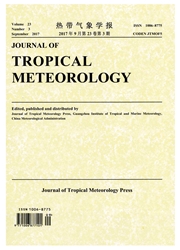

 中文摘要:
中文摘要:
Using the 1970-2005 annual precipitation and evaporation data at 80 gauge stations across Hunan province,this work analyzes the spatial distribution and variation tendency of the local droughts and floods using linear regression,wavelet analysis,abrupt change,clusters,Empirical Orthogonal Function (EOF) and rotated EOF (REOF).Results show that there are four dry areas and three wet areas in Hunan.The whole province exhibits a moistening trend except some small areas in western,eastern and southern Hunan.The most prominent feature of annual precipitation is that the whole province basically displays a consistent variation tendency,as far as the dominant EOF mode is concerned.In addition,the spatial features of the other EOF modes include dry-wet differences,e.g.wet (or dry) in the north versus dry (or wet) in the south,wet (or dry) in the center and dry (or wet) in the surrounding areas.The distribution of the ratios of evaporation to precipitation exhibits both common features as well as spatial differences,which can be classified into four types:South Hunan,North Hunan,Northeast Hunan,and Central Hunan.There is an abrupt change from dry to wet patterns in the early 1990s.Generally,the drought-flood distribution presents variations of three periods.In the late 2000s,Hunan province will be in a period of drought,followed by a period of flood.
 英文摘要:
英文摘要:
Using the 1970-2005 annual precipitation and evaporation data at 80 gauge stations across Hunan province,this work analyzes the spatial distribution and variation tendency of the local droughts and floods using linear regression,wavelet analysis,abrupt change,clusters,Empirical Orthogonal Function (EOF) and rotated EOF (REOF).Results show that there are four dry areas and three wet areas in Hunan.The whole province exhibits a moistening trend except some small areas in western,eastern and southern Hunan.The most prominent feature of annual precipitation is that the whole province basically displays a consistent variation tendency,as far as the dominant EOF mode is concerned.In addition,the spatial features of the other EOF modes include dry-wet differences,e.g.wet (or dry) in the north versus dry (or wet) in the south,wet (or dry) in the center and dry (or wet) in the surrounding areas.The distribution of the ratios of evaporation to precipitation exhibits both common features as well as spatial differences,which can be classified into four types:South Hunan,North Hunan,Northeast Hunan,and Central Hunan.There is an abrupt change from dry to wet patterns in the early 1990s.Generally,the drought-flood distribution presents variations of three periods.In the late 2000s,Hunan province will be in a period of drought,followed by a period of flood.
 同期刊论文项目
同期刊论文项目
 同项目期刊论文
同项目期刊论文
 期刊信息
期刊信息
